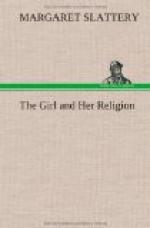A careful observation of the ways of presenting great men of history and great characters in literature to young people will convince one beyond doubt that the girl may store the facts in the memory for a time, but if the living personality is presented it will remain to mold and guide and influence the life. The teacher’s greatest power is never in what she teaches but in what is revealed to the individual through her teaching. The mind hungers for facts, searches for facts and wearies of facts. It follows personality.
When Richard Watson Gilder tried to voice the plea of the young doubter, puzzled, perplexed and suffering from the great array of apparently conflicting facts and most of all from his own failure to win out over the temptations that swept over him he said:
“Thou Christ, my soul is hurt and
bruised!
With words the scholars wear
me out;
My brain o’erwearied and confused,
Thee, myself and all, I doubt.
And must I back to darkness go
Because I cannot say a creed?
I know not what I think! I know
Only that Thou art
what I need.”
The fact is not enough. John Kendrick Bangs says it forcibly—
“A mere acceptance of the fact of
love of God above,
Of all the vast omnipotence of Him our
Maker and Defence
Is not believing.”
Slowly we are getting back to the recognition of the proper place of fact, of its power as the background and basis against which and upon which Personality must stand. Our eyes are opening to see that if the girl is to gain a religion which shall mean life, she must gain it through a person who reveals a Person.
Here is Mary D——, a girl of fifteen, a worker in a mill employing a very cheap grade of help. Her face was hard, there was no light of anticipation in her eyes—she had nothing to anticipate. She toiled through the long hours, for there was no limit to her day in the state where she lives. Her home was not a home but a place where she could stay nights—when her father was not so quarrelsome through cheap drink that he drove her out. One day a woman at a noon service in the factory shocked at a profane remark of Mary’s said reprovingly, “Don’t you believe there is a God?” “Sure I do,” said Mary, “but I don’t see’s it makes no difference to me.” Further questions followed and Mary declared her belief, adding, “I don’t bother much about them things.” Mary had some facts and declared some sort of belief in them, but they made no difference.
[Illustration: THE FUTURE PROMISES NOTHING AND SHE HAS LOST HOPE]
The next summer, Mary, overcome by the work of the year and an attack of the grippe, was sent by a woman in one of the churches, to a girl’s camp. She lived in decent fashion, she saw a lake, great mountains, sunsets and stars! She found flowers and sat quite still watching birds that seemed so marvelous to her.




